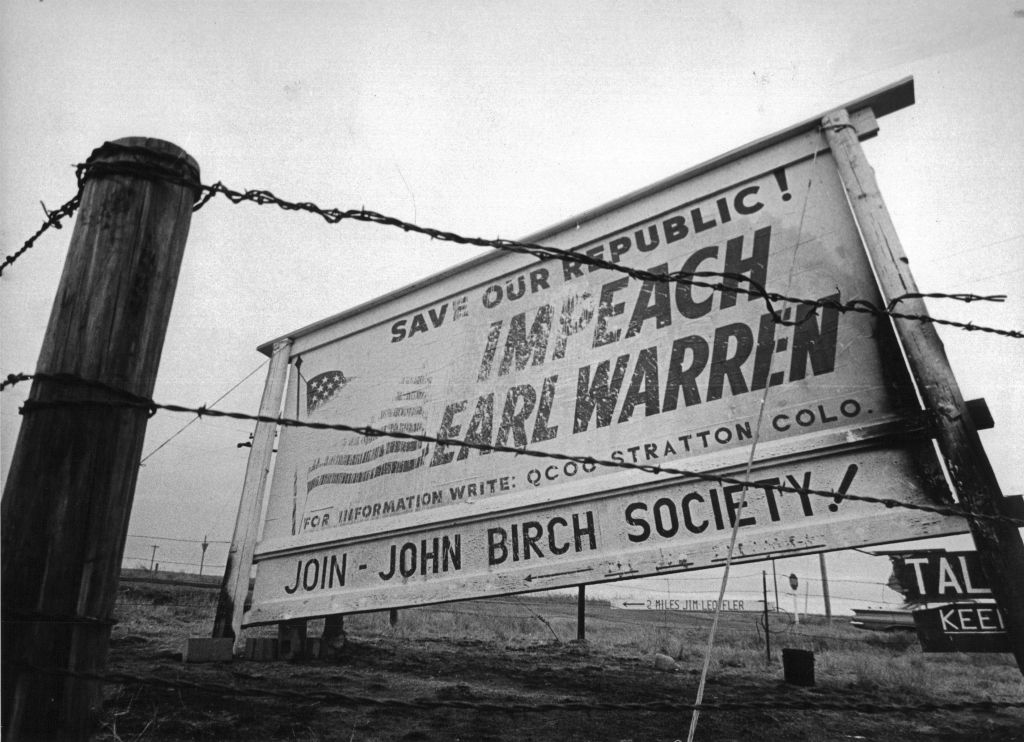House Republicans are in disarray, paralyzed and with no sign they can unify around a candidate for speaker. At the crux of the problem is a question Representative Kat Cammack (R-Fla.) asked in January during the last speaker fight: “Are we the party of Reagan?” Ten months later, the answer is resoundingly no. The far right toppled House Speaker Kevin McCarthy, and ran a bruising campaign to install one of their own, Ohio Representative Jim Jordan—a man former speaker John Boehner once branded a “legislative terrorist”—in the job. It failed, but the chaos epitomizes how over the last decade, the GOP has largely replaced the ideological tenets of Reaganism with a worldview inherited from the John Birch Society (JBS), a formerly marginal far-right movement from the 1950s and 1960s.
For decades, conservative leaders tried to consign the Birchers and their intellectual heirs to the fringes of their coalition, but today’s Republicans are awash in Birch ideas. These include rampant conspiracy theories (notably about vaccines and election denialism), a penchant for isolationism, and a belief that federal law enforcement agencies are “the enemy of liberty,” in the words of Rep. Matt Gaetz (R-Fla.), who led the fight to oust McCarthy. The Birchers' violent penchant for threatening opponents has even been on display in the campaign to pressure holdouts to vote for Jordan.
Fundamentally, what it means to be a conservative or a Republican has changed in recent years. Political ideas and attitudes that bear the imprint of the JBS are newly dominant. Eight years after Donald Trump’s arrival on the scene, this remains shocking, even jarring, and leaves us to wonder: How did the fringe engulf the GOP?
In 1958, a small group of anti-New Deal businessmen led by candy magnate Robert Welch founded the JBS. They named the group after a U.S. Army officer slain by Chinese communists—an apt choice for a group so obsessed with rooting out communism that it often subscribed to conspiracy theories. The JBS alleged, for example, that President Dwight D. Eisenhower was a secret communist and warned against the fluoridation of water.
Read more: The 'Zealot' Who Gave the John Birch Society Its Name
Yet, even as mainstream Americans rejected such notions or denounced the group outright, it nonetheless established an alternative political tradition that challenged the ideology and sensibilities of not just mainstream Republicanism—which then was center-right—but also mainstream conservatism. Many issues separated mainstream conservatism from the Bircher fringe, but the most important and profound distinctions centered on explicit racism, anti-interventionism vs. internationalism, tolerance of conspiracy theories, and a more apocalyptic, violent, antiestablishment mode of politics.

Birchers aggressively opposed the civil rights movement as a Kremlin-directed plot. They charged that Chief Justice Earl Warren intentionally abetted the communists, distributed flyers calling President John F. Kennedy a traitor, and repudiated NATO. None of these claims sat well with more mainstream conservatives. Birchers’ criticisms of government (“one worlders”) and media helped spark a revolt against America’s institutions and its elites at a time when trust in both was diminishing across the ideological spectrum. Birchers lobbied school boards to ban supposedly communist teachings such as sex education, shouted down speakers in public forums, formed front groups to push their causes in secret, and deployed fear and intimidation as political weapons, threatening to inflict unspecified harms on their foes.
Read More: The House Goes Another Day Without a Speaker as Jim Jordan Hunts for Votes
While mainstream conservatives sometimes aligned with the JBS on discrete issues and in particular moments, the two sides were more antagonists than partners, each seeing the other as an enemy within whose influence must be squashed. In the mid-1960s, especially after Barry Goldwater’s landslide defeat in the 1964 presidential election, some liberal and moderate Republicans and Democrats and civic groups such as the NAACP and the Anti-Defamation League undertook an ad-hoc campaign to vilify the society. This effort helped turn it into an epithet, and the organization shriveled in the 1970s.
But although it faded as a group, the JBS bequeathed a set of fringe ideas to a host of successors. These included activists like leading anti-feminist Phyllis Schlafly and religious leaders like Pat Robertson, who were instrumental in the GOP moving rightward on cultural issues like the Equal Rights Amendment and abortion. The Birchers’ vilification of government as the nation’s greatest enemy also moved to the center of the Republican agenda by the 1990s.
In the wake of the Cold War, the America First isolationist vein of Bircher thinking resurged as well, most clearly in commentator Pat Buchanan’s “America First” presidential campaigns in 1992 and 1996. The election of Bill Clinton, the first Democratic president in 12 years, alongside the rise of a new group of conservative broadcasters like talk radio host Rush Limbaugh, popularized false conspiracy theories on the right—including allegations that Clinton and First Lady Hillary Clinton murdered their friend and Deputy White House Council Vince Foster, who had tragically died by suicide.
Although George W. Bush courted the fringe during his 2000 presidential campaign, including a stop at Bob Jones University, which barred interracial dating, he rejected the far right’s agenda once in office. His “compassionate” conservatism included education and immigration reform, as well as a muscular, internationalist foreign policy. Bush championed free trade, forged close ties to Mexico and Canada, strengthened some of America’s alliances overseas, built a domestic security state, and pushed out GOP Senate leader Trent Lott for praising Strom Thurmond’s pro-segregation 1948 presidential run. He even added a prescription drug benefit to Medicare.
By the end of his term, however, the GOP had turned on Bush—epitomized by the rejection of his bipartisan immigration reform bill in 2007 and the refusal of many congressional Republicans to support the TARP economic rescue plan in the fall of 2008.
The grinding war in Iraq, coupled with Bush’s attempt to bail out big banks to prevent economic catastrophe, helped the right-wing fringe achieve a goal that dated back to the Birchers: toppling conservative GOP institutionalists. The election of Barack Obama brought some of the Birchers’ more explicit racism back into GOP politics. Even one-time Republican vice-presidential nominee Sarah Palin spread the false, racist conspiracy theory that Obama’s birth certificate was fake. This “birtherism” exposed how the Birch-like, apocalyptic approach to politics and policy had become central to the GOP. The grassroots Tea Party uprising, which fueled a Republican wave election in 2010, included a strong Birchy, anti-GOP-elite element.

All of this was a precursor to the Trump years, when the fringe finally became the dominant force in the GOP.
Fundamentally, the victory by the far-right insurgents had three causes. First, they were able to learn from the Birchers’ failings and avoid their mistakes, even while deploying the group’s framework for understanding and approaching politics and culture.
Second, Republican leaders spent decades courting the fringe. They saw far-right support as necessary to victory and gambled that they could harness the extremists’ energy while limiting their worst impulses. Republicans assumed that they could court radicals during campaigns, and then govern pragmatically, throwing just enough red meat to the extremists to keep them sated.
Read More: Which Republican Party?
While this strategy worked in the short term, it produced unrealistic expectations for what the GOP could and would deliver. Decades of unfulfilled promises left the hard right feeling betrayed and demanding politicians who would follow through. They took to weaponizing primaries to purge the GOP of insufficiently far right politicians, aided and abetted by a new media and social media ecosystem that made it harder for Republicans to control the information their voters received.
Finally, far-right activists benefited from changes to the economy, culture, and world that fueled alienation among the white working class and some elements of the middle- and upper-classes. An influx of immigrants of color, deindustrialization, and a widening income gap threatened the belief of many white Americans that the U.S. was a white Christian country. It also undermined their faith in the American Dream. The severing of white working-class voters from unions also helped break their connection with the Democratic Party and New Deal liberalism.
That left these voters susceptible to the successors of the Birch Society who stoked their anger and spun conspiracy theories to explain their struggles. They argued that an elite cultural establishment sneered at white voters and their values, while trying to use government power to help everyone else.
The end of the Cold War created new space for isolationists to attack America’s internationalist leadership. Initially, the aftermath of 9/11 undercut these America First sentiments, but the quagmires in Afghanistan and Iraq eventually eroded the right’s commitment to Reagan’s robust internationalism.
Even in the pre-talk radio, cable news, and Internet age, establishment conservatives couldn’t banish the right-wing fringe from American politics altogether. But in the early 21st century, the rise of dark money, social media, and conservative media make it harder to imagine a world where the MAGA fever is broken, and the Jordan and Trump wing is expelled from the conservative mainstream.
That does not mean, however, that MAGA’s control over the GOP is unshakeable. Trump and his followers have lost three straight national elections. And the fate of the Birchers and their descendants suggests that should they keep losing winnable races, eventually, perhaps, their opponents will gain enough clout to return them to the political fringe.
Matthew Dallek, a professor at George Washington’s Graduate School of Political Management, is author, most recently, of Birchers: How the John Birch Society Radicalized the American Right.
Made by History takes readers beyond the headlines with articles written and edited by professional historians. Learn more about Made by History at TIME here.
More Must-Reads from TIME
- Cybersecurity Experts Are Sounding the Alarm on DOGE
- Meet the 2025 Women of the Year
- The Harsh Truth About Disability Inclusion
- Why Do More Young Adults Have Cancer?
- Colman Domingo Leads With Radical Love
- How to Get Better at Doing Things Alone
- Michelle Zauner Stares Down the Darkness
Write to Matthew Dallek / Made by History at madebyhistory@time.com
